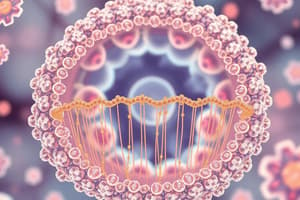Podcast
Questions and Answers
What term describes the movement of substances across the cell membrane without the need for energy?
What term describes the movement of substances across the cell membrane without the need for energy?
Active transport moves substances from low concentration to high concentration using energy.
Active transport moves substances from low concentration to high concentration using energy.
True
What does the sodium-potassium pump use to transport particles against their gradient?
What does the sodium-potassium pump use to transport particles against their gradient?
What is the function of channel proteins in membrane transport?
What is the function of channel proteins in membrane transport?
Signup and view all the answers
Osmosis refers to the movement of solutes from an area of lower solute concentration to an area of higher solute concentration.
Osmosis refers to the movement of solutes from an area of lower solute concentration to an area of higher solute concentration.
Signup and view all the answers
The cell membrane is described as having __________ permeability, allowing it to control what enters and exits the cell.
The cell membrane is described as having __________ permeability, allowing it to control what enters and exits the cell.
Signup and view all the answers
What are the three types of tonicities?
What are the three types of tonicities?
Signup and view all the answers
Water moves from an area of _____ osmolarity to an area of _____ osmolarity.
Water moves from an area of _____ osmolarity to an area of _____ osmolarity.
Signup and view all the answers
Which of the following substances would use facilitated diffusion to cross the cell membrane?
Which of the following substances would use facilitated diffusion to cross the cell membrane?
Signup and view all the answers
Simple diffusion allows all types of substances to pass through the membrane easily.
Simple diffusion allows all types of substances to pass through the membrane easily.
Signup and view all the answers
Match the terms related to osmolarity with their definitions:
Match the terms related to osmolarity with their definitions:
Signup and view all the answers
Match the transport methods with their description:
Match the transport methods with their description:
Signup and view all the answers
Which of the following describes a non-penetrating solute?
Which of the following describes a non-penetrating solute?
Signup and view all the answers
Name one example of a process that requires carrier proteins for transport across the cell membrane.
Name one example of a process that requires carrier proteins for transport across the cell membrane.
Signup and view all the answers
Osmosis can occur when there is no concentration gradient present.
Osmosis can occur when there is no concentration gradient present.
Signup and view all the answers
The term _____ refers to the relative solute concentration that considers both solute concentrations and cell membrane permeability.
The term _____ refers to the relative solute concentration that considers both solute concentrations and cell membrane permeability.
Signup and view all the answers
Study Notes
Cell Membrane Structure and Function
- The cell membrane separates cellular contents from external fluids and regulates molecule transport.
- It facilitates the import of chemical signals and building materials essential for cell processes, while exporting waste products and secretions.
- Selective permeability controls what substances can enter or exit the cell.
Membrane Transport Methods
- Diffusion: Movement of solutes from high to low concentration without energy.
- Active Transport: Requires energy (ATP) to move substances against their concentration gradient (low to high).
Diffusion Process
- Solutes move down their concentration gradient until equilibrium is reached.
- Simple Diffusion: Lipid-soluble substances pass directly through the lipid membrane; water-soluble substances need assistance.
- Facilitated Diffusion: Water-soluble or fat-averse substances cross membranes via embedded membrane proteins (channels and carriers).
Protein Types in Facilitated Diffusion
- Channels: Form watery tunnels that allow specific substances (e.g., aquaporins for water) to pass; can be regulated by gates.
- Carrier Proteins: Help transport substances like glucose by changing shape to enable crossing the membrane; have a maximum transport rate dependent on availability.
Active Transport
- Sodium-Potassium Pump: Example of active transport utilizing ATP; pumps sodium ions out and potassium ions into the cell against their gradients to maintain concentration differences critical for cell function.
Osmosis and Osmolarity
- Osmosis: Movement of water through a semipermeable membrane from low solute concentration (high water) to high solute concentration (low water).
- Non-penetrating solutes (e.g., sodium) cannot cross the membrane, leading water to move instead to equalize concentrations.
- Osmolarity: Measure of solute concentration (mOsm/L); determines water concentration based on particle number not size.
Tonicity Terms
- Isotonic: Equal solute concentrations; no net movement of water.
- Hypotonic: Lower solute concentration outside the cell; water moves in, possibly causing cell swelling.
- Hypertonic: Higher solute concentration outside the cell; water moves out, potentially leading to cell shrinkage.
Outcomes of Tonicity
- Semipermeable membranes will result in net water movement toward areas of higher osmolarity, affecting cellular volume depending on the tonicity of the solutions separated by the membrane.
Studying That Suits You
Use AI to generate personalized quizzes and flashcards to suit your learning preferences.
Description
Explore the essential functions and structure of the cell membrane in this quiz. Test your understanding of membrane transport methods, including diffusion and active transport, and how the cell membrane regulates the movement of substances. This quiz will help reinforce your knowledge of cell biology concepts.




